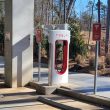How local governments can encourage residents to make smart energy choices
Local governments play an essential role in creating a safe environment for their constituents to live, work and play. While we don’t typically think of preparing for extreme weather events as a priority for municipal or county leaders, it has never been more important. The impact of climate disruption is being felt far and wide. According to a recent Washington Post analysis, more than 40 percent of Americans live in counties impacted by climate-related extreme weather in 2021.
Our aging grid is an example of critical infrastructure that can be stressed to its breaking point due to climate disruption. This is especially true during the summer months when air conditioners are set to full blast. Summers are getting hotter, and utilities must get creative to keep electricity flowing safely. While it’s not a solution that will solve every challenge our grid faces, creating a demand response (DR) program can make a big difference. DR programs work by rewarding customers with an incentive payment or another form of financial compensation when end-users reduce their usage during a period of high demand. It’s a win-win: end-users save money and utilities ensure the grid keeps up with demand.
All eyes are on supply and demand
Lately, energy has been a popular topic of discussion across several areas—from political, to legal, to environmental. A recent Technology Quarterly in The Economist was dedicated to climate technology and the energy transition. At the annual IEA Global Conference on Energy Efficiency, U.S. Principal Deputy Assistant Secretary for Energy Efficiency and Renewable Energy stated that energy efficiency “could be the peace project of our time,” insisting that “Russia’s unlawful invasion of Ukraine has challenged us to think differently about how we generate, distribute and use energy, and the case for energy efficiency has never been more urgent.” Undoubtedly, energy and how it will be managed and distributed in the future has people talking.
Beyond increased media attention, there has never been more interest from end users in DR programs. Some residents are interested in the cost-saving benefits, others are interested in having more control over their energy consumption, and still others are looking to make more environmentally friendly decisions. For the majority, it’s a little bit of everything. The fact is the time is right for local governments to support DR programs. These programs have broad appeal and ensure vital services keep running even during spikes in energy demand. Now the question is, how?
How local government can be part of the solution
While DR programs aren’t a complex concept, the execution part becomes a little more complicated. DR programs have several moving parts that need to be considered—everything from technology implementations (smart meters, analytics solutions, etc.) to compensation and billing. In terms of the development and implementation of DR programs, utility companies do a lot of the heavy lifting. However, there are ways that local governments can support these initiatives and make the process smoother.
For example, local governments can ensure regulatory requirements don’t become a barrier to a program’s deployment or hinder end-user adoption. Local governments also play an integral part in educating residents about energy and environment-friendly practices. Adding information about a DR program to educational materials can go a long way in encouraging end users to allow the installation of smart meters and boost program sign-ups. Even the best thought out program won’t be successful if no one signs up.
Local governments can also begin saving residents money by ensuring all local government buildings participate in a DR program, as The Economist noted that “the commercial and industrial market for flexible demand is taking off too.” Government buildings that participate in these programs will not only reap their own financial benefits, but also encourage local residents to sign their households up for DR programs once they see the cost savings these programs provide. To take it even one step further—embracing distributed energy resources (DERs) such as solar panels can lower costs even more and empower local governments to sell excess energy back to the grid during peak periods.
It takes a village: local government plays a vital role in keeping the lights on
Local governments can’t create a demand response program alone, but they have a critical role to play. As temperatures rise, the risk of demand eclipsing supply increases. The consequences of brownouts and blackouts that occur when the grid can’t keep up will only continue to increase in severity, putting the most vulnerable at risk. By supporting DR initiatives, local governments can help ensure electricity keeps flowing and their residents stay safe.
Mike Ting is a senior product manager in Itron’s distributed energy management team, overseeing Itron’s strategies and product roadmaps related to DER management solutions that leverage its networks and distributed intelligence technologies. Prior to his product management role, Ting spent 20+ years in public and private sector research and consulting to utilities, government agencies and other stakeholders related to energy efficiency, demand response and energy policy, including stops at the International Energy Agency and Lawrence Berkeley National Laboratory.




















